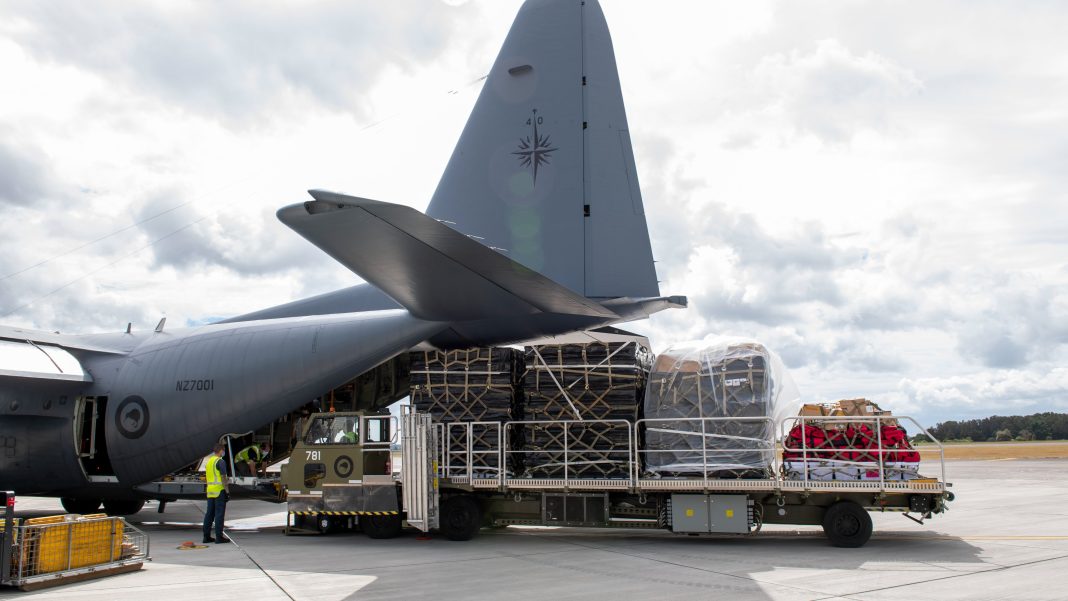Tonga has turned back an aid flight from Australia due to a positive Covid case on board, despite assurances from the Morrison government that humanitarian relief from the volcanic eruption and tsunami could be offered in a Covid-safe way.
Tonga is Covid-free and has a strict border control policy, requiring contactless delivery of aid that began arriving by plane last Thursday.
The Australian aid flight left Brisbane last Thursday afternoon but was turned around mid-flight after being notified of the positive Covid case, an Australian defence spokeswoman said.
All crew had returned negative rapid antigen tests before departure, but PCR tests later showed the positive result. The supplies were moved to another flight that took off on Friday.
The Hunga Tonga-Hunga Ha’apai volcano eruption last Saturday triggered a tsunami that destroyed villages, resorts and many buildings, and knocked out communications for the nation of about 105,000 people. Three people had been reported killed, authorities said.
Last Monday the Australian minister for international development and the Pacific, Zed Seselja, told the ABC that Australia had developed protocols “for how humanitarian supplies can be delivered in a Covid-safe way” by minimising person-to-person contact.
Seselja committed to “comply with whatever requirements the Tongan government has for anyone entering the country”.
“We absolutely respect the need and the desire for the Tongan people to make sure that they don’t have Covid come into the country, even if it’s through humanitarian flights,” he said.
Australia’s prime minister, Scott Morrison, spoke to his Tongan counterpart, Siaosi Sovaleni, last Wednesday, reassuring him that Australia was “placing the highest priority on delivering support in a Covid-safe way”.

Almost a week since the eruption, Tongans are struggling to find clean drinking water with their island homes shrouded in volcanic ash.
“We are cleaning the ash and have been since Monday,” Branko Sugar, a 61-year-old who runs a bottle shop and fishing charter business from the capital Nuku’alofa, said.
“Everything is so dusty, and we are running out of water,” he said over a patchy telephone line.
“We only have the tap water, and it’s been contaminated. We’re just cleaning, cleaning, cleaning and can hardly breathe for all the dust.”
The first aid flights from Australia and New Zealand landed in Tonga on Thursday with much-needed supplies of water for sanitation and hygiene as well as shelter, communication equipment and power generators.
A New Zealand maritime sustainment vessel HMNZS Aotearoa carrying 250,000 litres of water and able to produce 70,000 litres per day through a desalination plant, arrived on Friday.
Australia’s HMAS Adelaide en route from Brisbane is due in Tonga this week.
United Nations spokesperson Stéphane Dujarric said in a briefing that Tonga had asked for urgent assistance and the agency is in close contact with the authorities.
“Assessment teams have reached most parts of the country, including remote and isolated islands,” Dujarric said.
“We remain seriously concerned about access to safe water for 50,000 people throughout the country. Water quality testing continues, and most people are relying on bottled water,” he said.
Some 60,000 people have been affected by damage to crops, livestock, and fisheries due to ashfall, saltwater intrusion and the potential for acid rain, Dujarric said. There are also reports of fuel shortages, he added.
Australia’s foreign minister Marise Payne said on Friday cash donations to Tonga for immediate humanitarian supplies – Australia has donated $1m(US$718,000) – would need to be followed with more substantial support for rebuilding.
“The impact of this volcanic eruption and the subsequent tsunami and the damage the inundation is causing will be an ongoing challenge for Tonga, particularly in relation to infrastructure,” she said.
Telephone links between Tonga and the outside world were reconnected last Wednesday, although restoring full internet services is likely to take a month or more.
Tongans have turned to social media to post images of the destruction by the tsunami and give accounts of their shock after the massive explosion.
Nasa’s Goddard Space Flight Center has said the force of the eruption was estimated to be the equivalent of five to 10 megatons of TNT, or more than 500 times that of the nuclear bomb the United States dropped on the Japanese city of Hiroshima at the end of World War Two.
SOURCE: THE GUARDIAN/ PACNEWS














